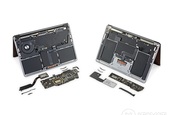This article is more than 1 year old
The world's first Apple Silicon iMac is actually a Mac Mini
Bit of a pain switching the thing on, but you can't have everything
Unwilling to wait the few months until the launch of the first Apple Silicon iMac, a popular retro computing vlogger has retrofitted a 2011 27-inch model with the innards of the latest M1 Mac Mini. And it worked. Sort of.
This wasn’t as hard as you might expect. YouTuber Luke Miani's first step was to remove the internals of the donor iMac, stripping away anything that wasn't welded to the chassis. He then connected the display to a third-party converter board acquired from eBay, which transformed the signals from the all-in-one display into something that can be outputted via HDMI or DVI.
Then it was a matter of extricating the innards of the M1 Mac Mini and affixing them within the iMac chassis. As previous teardowns have noted, the latest-and-greatest is effectively a single-board computer in some fancy packaging, making it easy to transplant between form-factors. The only other part Miani had to worry about was the machine’s power supply.
The vlogger encountered just one hurdle: one of the Mac Mini’s three Wi-Fi and Bluetooth antennas was soldered to the Mac Mini chassis. Fortunately, it used the same standard connector as the donor iMac, allowing him to re-use one of the antennas already present in the all-in-one.
Remarkably, the Frankenstein-ed concoction worked, albeit with one caveat: both the power button and the ports were physically located within the machine.
If Miani needed to turn the computer on, or connect a peripheral, he'd have to physically remove the display. This involves using two suction cups to lift the delicate glass protecting the LCD panel, which is itself a perilous task, and then gingerly removing the screen housed underneath.
Although impractical, this project illustrates something widely known in the retro tech scene: earlier iMacs are insanely versatile, and if you’ve got a bit of imagination, you can stretch their lifespan beyond what Apple would typically permit. For those unafraid of a bit of technological vivisection, turning an iMac into an external monitor is a straightforward (albeit time-consuming) task. You just need to buy the same converter board Miani used and feed an HDMI cable through an aperture in the back.
Early iMacs are also shockingly upgradable, at least by Apple’s standards. The 2011 model, for example, comes with a socketed CPU, replaceable RAM and storage, as well as room for a discrete graphics card . If you’re willing to splash the cash, even a decade-old machine can become a solid work-horse, provided you align your expectations accordingly.
Although Apple stopped supporting the 2011 iMac with macOS 10.14 Mojave, you can upgrade it to a supported version (namely Catalina) using a third-party patching tool, like that offered by DosDude1. Alternatively, it can run Linux or Windows 10 without any real issues.
And they’re cheap, too. The same model used by Miani can be found for around £350 on eBay, making it a tempting homeschooling or backup computer.
Watchers of Cupertino have said they expect the first Apple Silicon iMac to launch in the second half of this year – although other rumblings we’ve heard pinpoint its announcement for later month, coinciding with Apple’s annual Spring event.
Jon Prosser, a well-connected Apple leaker has claimed the new machines will come in a range of colour schemes reminiscent of the first iMac G3 series, including a rose gold (or copper) and lime green design.
Hello, 1998.
— Jon Prosser (@jon_prosser) February 24, 2021
iMacs.
Colors.
They’re back. 😳https://t.co/Rho9SmK9I6 pic.twitter.com/YkKgoEFYCa
As a collector of retro Apple kit, this correspondent can’t help but point out that the iMac G3 also came in “dalmatian blue” and “flower power” motifs. Yes, they’re as garish as you imagine. And while nostalgia is an undeniably powerful force, we can’t see Apple’s trip down memory lane making that particular turn. ®

